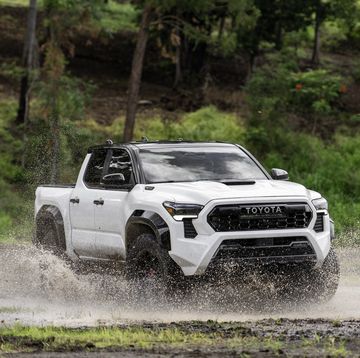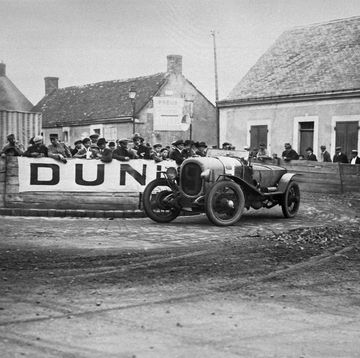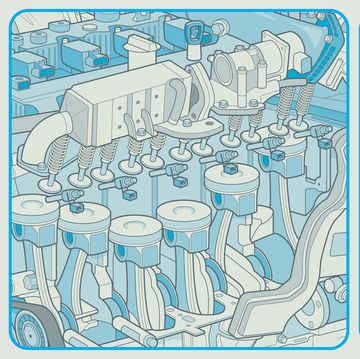I’ve spent the last 24 hours recovering from Luft 9, the ninth iteration of the now globally-known Porsche gathering. In the last decade it has become one of the year’s must-do events for marque fans. Over two days, over 1,000 cars were put on curated display and nearly 10,000 people pay good money to show them, see them, be seen, eat, drink, and create content.
Throughout the weekend’s two main events, Saturday’s air-cooled only Luftgekühlt (German for Air Cooled) and Sunday’s “Air/Water,” featuring all makes and models from Porsche’s 70 year history, I asked myself and others the same semi-rhetorical question over and over: “Why has no one copied this yet?”
“This” is the brainchild of Patrick Long and Jeff Zwart, two legends of the Porsche world for different but occasionally intersecting reasons.
Long is one of the rare few who have held the distinguished title of Porsche Factory Racing Driver. Under his belt rests five class podiums and two class wins at the 24 Hours of Le Mans, as well as countless other victories in IMSA, Grand AM, and GT racing. A Southern California native, Long has lived and breathed Porsches virtually his entire life. Even in his “retirement” from professional racing, Long continues to not only work closely with Porsche on events and marketing, but also can be frequently spotted in his racing suit behind the wheel of some astonishingly valuable vintage machinery in the Le Mans Classic or Monterey Historics. Just two weeks ago I watched as Long took home first place in a vintage Formula 1 race supporting the Long Beach Grand Prix, behind the wheel of Keke Rosberg’s 1983 ride. “It weighs 800 pounds and your feet are the crash structure. It was mega sketch,” he tells me, with a satisfied smirk.
Zwart is a California native as well who notes that his parents carted him around in a 356 as a child. He grew up to be an incredibly accomplished automotive photographer, then videographer, cinematographer, and director, and finally, a racing driver, with multiple class wins at the Pikes Peak International hillclimb from behind the wheel of various race-prepped Porsches. Nearly every iconic Porsche print ad from the Eighties and Nineties is paired with a Jeff Zwart photograph, as are the vast majority of Road & Track covers during the same time period.
“Pat and Jeff are the ultimate stewards for a show like Luft, because not only do they live and breathe Porkers, they are also just great humans, and that makes you want to root for them,” says Hoonigan Industries co-founder and marketing genius Brian Scotto. “But the timing of Luft’s entry to the marketplace was spot on. In the past decade, vintage Porsches transcended from the ultimate enthusiast tool to a fashion accessory. This brought in a new audience that not only fit, but also was also willing to spend extra for that curated experience. But the magic that the Luft team has managed to perform is keeping those original enthusiasts engaged, despite having to rub shoulders with the Porsche neophytes.”
And unlike, say, the Pebble Beach Concours other Monterey Car Week events, Luft is much more likely to accept “lesser,” non-original enthusiast entries. Far more people enter to show a car at Luft than get accepted, which is a reality of popular gatherings, but not every car on display is a million-dollar preservation piece. Some are heavily modified, some are half rusted full of “character.” The kings of Luft include professional “outlaws” like Rod Emory, Singer, and Guntherwerks, which charge deep into the six and seven figures for their air-cooled creations and whose customers are skewing younger.
“The Porsche brand comes from somewhat humble beginnings, and has evolved to something bigger. So we want to share that story, and embrace the themes of the brand,” Zwart muses, before rattling off a few key factors: the connection to motorsports, durability in using the cars as intended, style, individualization from factory specifications, and aftermarket customization. “We then use subtle cues to call back to the brand’s history, such as the wooden platforms we place the feature cars on. They are wood because Porsche was started in a saw mill. There’s little easter eggs all over the show.”
While Long and Zwart’s passion for the brand’s history is infectious, it is perhaps Zwart’s cinematographer’s eye that helps Luft stand out from any other car show you may have attended. The setting changes each year, and always manages to be the kind of place you could never imagine a car show being, only to arrive and discover you should never have car shows anywhere else: a lumber yard in South LA, cars carefully placed between towering pallets of wood; the Universal Studios Back Lot, cars delicately arranged as props in movie sets and fantasy towns; now, a dilapidated navy yard in Vallejo, CA, with cars elegantly placed against faded, aging industrial backdrops, among submarine parts and enormous cranes, some tucked away into tiny back alleys in far corners of the enormous property. I can imagine the owners of those cars first peeved, then delighted to be part of a private little Zwart diorama for anyone lucky enough to stumble upon.
What kind of person finds these locations perfect for an exotic car show? Someone with a background in making car commercials, that’s who. Someone who spends half their life location scouting. “I really try to set up the cars in a way that they will create the perfect photo opportunity,” says Zwart, who places the cars, one at a time in the 24 hours leading up to the show, in what ends up being the most photogenic place possible. The cars pre-stage in an area on the edge of the site, and Zwart, atop a well-worn carbon fiber road bicycle, zooms back and forth, leading each car to its idealized backdrop, then zipping back to the lot for the next one.
“I put the car exactly where I would want it if I was taking the photo. But now everyone is carrying their own camera - all you need today is a phone - and I let you hit the shutter yourself. Some of the shots come out better even than I could have imagined.”
Every Luft provides an opportunity for literally hundreds of posters, especially if you shell out the few extra bucks for an “early access” ticket, giving you entry a couple hours before everyone else, to get the perfect shot in the morning light, without any people.
“Luft has elevated and curated the car show concept specifically for social media photography and Instagram,” Scotto tells me in a text message. “When I showed my own car at Luft 3, as soon as I pulled in, Jeff exclaimed ‘Oh, I have the perfect spot for a white car with red wheels,’ and he was right - the photos taken of that car against the background he chose are like a hero poster.”
Legendary photographer Larry Chen agrees. “The placement of the vehicles, the backdrop and location are the most important distinguishing factor. The art and beauty of everything makes it so accessible to anyone with a phone camera. Even though these machines were built for speed, they sit still and look incredible for LUFT.”
Some have suggested, prodded by my informal survey, that Southern California is crucial to the success of Luft, to which Zwart replied “LA car culture is definitely a part of it, though the show doesn’t have to be in LA to succeed. Both Patrick and I are from Southern California, and so I think we bring that SoCal aesthetic with us just kind of by default. There’s this euphoric idea of SoCal around the world. When we did an event in Munich, more than one person thanked me for ‘bringing SoCal to Germany.’ But ultimately I think that Porsche’s common language, racing, style, individuality, and putting miles on the cars to travel to these shows presents very well as a SoCal point of view.”
As I walked around the Mare Island shows this weekend, my eyes always finding something new to admire, some quiet back corner of a building I thought was empty where, no, actually, a blue and gold 1973 2.7 RS sat quietly placed against a matching hue of a wall, I hypothesized over and over why no one else has copied this formula yet? After all, how hard could it be to reverse engineer the Luft concept? And the harder I tried to mentally replace the cars with literally any other make of car the more I found myself failing to be able to make the math, or the imagery, work.
Why is that? It doesn’t seem that complicated. Don’t get me wrong--I know how much work goes into these shows, and I know that both Pat and Jeff are immensely talented and passionate people, but it’s been 9 years and no one has so much as attempted to properly recreate the Luft vibe for any other brand of car? How? Why? I started running checklists.
Ferrari? - Too focused on originality, and they would probably sue the event organizers.
Lamborghini?- Not enough cars and virtually no motorsports history.
Mustang? Camaro? MOPAR? - The fans wouldn’t pay for a premium experience.
Corvette? The ways in which “Corvette” is a lifestyle are … not good.
It’s not that you couldn’t find an unconventionally beautiful venue, find particularly interesting examples of a marque, and have someone with a knack for setting up a great photograph combine those two. That’s a hard task but not impossible. And yet, no one has even tried it yet, outside of these two guys?
Scotto seems to nail it: It’s driven by the diversity of the fans. “The blend of people interested in Porsches today is what makes Luftgekühlt possible. You don’t get the same diversity amongst Ferrari fans, or even Chevy fans. That said, it may change as pop culture and car culture continue to mix - Porsche just tipped first. If you tried to have Luft in the early Aughts, it would have been a lot of old dudes wearing Piloti shoes while complaining about PCA dues. It never would have grown beyond the parking lot of Deus.” (That's where Luft 1 was held, with 14 cars.)
He is right. Those old dudes are there too, but they now have the thing they didn’t even know they wanted. But the young, diverse people are driving the hype--taking photos, sharing them on social media. The cool kids are there, driving G-Body 911SCs on BBS and Panasport wheels. Young women are there. Kids are there. The cars are wild colors - paint, not wrap. There’s period mods, modern mods, backdates and power upgrades.
Guys in their 20s walk around with three different DSLRs draped across their shoulders. Who are you shooting for? I’d ask. “Myself” was the number one answer. The $10,000 Leica or Hasselblad was everywhere, but so were vintage 35mm, medium format, and even antique and 4x5 cameras. Luft provided a cornucopia of access to the subjects, and the settings that can’t help but make for a great photo.
It’s not like there aren’t other successful car show models, especially if success is judged financially. Corvettes at Carlisle, for example, is enormous and has been a thing since as long as I’ve been into cars. I’m sure there are a lot of nice people there, and some interesting examples of Corvettes. But just type “Corvettes at Carlisle” into Google Images and look at the photos. Now type in “Luftkeguhlt” into the search bar. It’s night and day. Even the Pebble Beach Concours d’ Elegance, held on the 18th fairway of America’s most prestigious golf course for the last 72 years, is rather dull by comparison. It’s pretty, no doubt, but stagnant. The cars, like the scenery, the dress code, and the people who attend, never really evolve. Good luck discerning which of those 72 events any given photo comes from.
Last year, as I was exiting Luft 8, held at an industrial brewery in San Pedro, CA, I asked Long about doing a show for water-cooled cars. I had a new 718 Spyder and wanted in on the action, and as the name explicitly says, Luft is air-cooled Porsche only. “Yeah, we’re gonna have to do something, I mean just look at that parking lot. I can’t be sure, but I think we accidentally have the largest gathering of GT3s in history out there. There’s like 1500 water cooled Porsches in that parking lot.” This year, they did just that, adding Air/Water, a second, slightly less carefully curated event on the same grounds as Luft that invites not just air-cooled 911s and 356s, but all Porsche models from the company’s history to attend.
“It’s a bridging community,” Zwart tells me over bluetooth while driving his race hauler sixteen hours back home to Colorado. “I grew up in a 356, but today, there is such a connection between the old cars and the new ones. You can drive a Panamera, or a Taycan, or one of Porsche’s mainstream everyday cars, and you can feel the connective spirit to the old stuff. And when you put the old cars and the new cars side by side at Air/Water, you can feel it makes sense. There aren’t a lot of other brands out there that have that.”
Chen adds, “Even with the incredible duo of Jeff and Pat, I'm not really sure any other brand could support a show like Luft. It's crazy to me to think of how narrow the focus was up until this weekend, when they finally let water cooled vehicles in for a second day event. It helps that Porsche owners are proud of the miles they put on their cars, so they are willing to make a road trip for this event, and also that the entry into the brand is actually still pretty easy considering the range of price for the higher end vehicles.”
“I really thought the car show was dead.” Says Scotto. “You had boring stuff like, you know, the GoodGuys shows, the swap meets, the old school stuff. You had the very hoity-toity Pebble Beach shows, but locals everywhere are totally hostile to Cars and Coffee type meets. In general, with car meets taking over bigger car shows, there isn’t a lot of reasons to pay for a car show these days. Luft is setting a standard of what we should expect going forward from car shows, and that’s very exciting.”

























